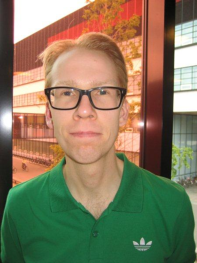Understanding Visual Absorption from First Principles
Promotion date: 7. September 2012
Promotor: Prof. dr. Claudia Filippi
| The visual opsin proteins represent an important family of photosensitive biosystems involved in the process of vision. All visual opsins share the same photoreceptor molecule, the retinal chromophore, while variations in the protein environment surrounding the chromophore are responsible for tuning its absorption over a wide range of wavelengths. In this thesis, the necessary theoretical ingredients were investigated extensively, for a quantitative account of how the protein environment tunes the absorption of the chromophore in Rhodopsin, the opsin responsible for dim-light vision. Initially - in order to differentiate between the intrinsic absorption properties of the chromophore and the effect of the protein environment - the focus was on the retinal chromophore in the gas-phase. This also allowed to thoroughly calibrate the theoretical approaches. Subsequently - to achieve a truthful description of the protein environment - a realistic model of Rhodopsin was employed in its native membrane environment. We performed rigorous quantum in classical molecular dynamics simulations at room temperature, to obtain an accurate structural description of the chromophore and properly account for the role of thermal fluctuations in tuning the absorption. To validate our results a wide range of accurate first principles approaches, was employed. |
What kind of phenomena caught your attention in the thesis project?
In the Biomolecular Electronics Structure group, we are interested in photosensitive bio-systems using computational methods to understand these systems. When studying these one does indeed come across many interesting phenomena.
An example is the impressive spectral tuning in visual absorption. On the molecular level, human vision is regulated by the visual opsin proteins. Remarkably, they all share the same photoreceptor molecule, while variations in the protein environment tune the absorption over a wide range of wavelengths from red to blue.
Using theoretical calculations to understand the molecular mechanisms involved in the absorption tuning is ideal, since these can give access to details not available in experiments. Furthermore, in the calculations, we can play with the systems, for example, by turning off certain interactions and then see how it affects the absorption.
However, at the start of my thesis project, it was not clear how to accurately describe the absorption of the visual opsins. For Rhodopsin - which can be considered the prototypical visual opsin - there were numerous different theoretical studies that reported apparent agreement with experiments but they reached rather contradictory conclusions on the role of the protein environment in tuning the absorption.
Of course, these different studies cannot all be right, so most likely they were getting the right answer for the wrong reason. Therefore, we set ourselves the goal of identifying the theoretical ingredients needed to obtain an accurate description of the absorption of the visual opsins.
To achieve this, we performed a rather comprehensive theoretical study where we considered the absorption of the chromophore both in the gas phase and in the protein environment. We carefully validated our results by employing a wide range of theoretical approaches for computing the absorptions.
This is in contrast with many previous studies that often employ just a single theoretical approach. Furthermore, for Rhodopsin, we employed a rather accurate model of the protein in its native membrane environment and properly accounted for thermal fluctuations in the chromophore-protein system, but that has been largely overlooked in previous studies.
Now at the end of my PhD, I believe that we have reached the goal set at the start of the thesis project and that we know how to achieve an accurate description of the absorption of the visual opsins. Furthermore, I have observed that many of the theoretical procedures commonly employed in previous studies of Rhodopsin, are inadequate and lead to an incorrect description. Therefore, it seems pretty clear that these previous studies, which reported apparent agreement with experiments, were getting the right answer for the wrong reason.
Can you mention some publications?
During my PhD, I managed to publish quite a few papers in nice journals like: Journal of Physical Chemistry Letters, Journal of Chemical Theory and Calculations, and Physical Chemistry Chemistry Physics.
Currently, I have more papers in preparation that should go out soon. I hope that these publications will help other researcher studying the visual opsins and guide them in how to obtain an accurate theoretical description of them.
What are your future plans?
I like to stay in academic research, as I like to learn something new every day, and not fall into routine work. Also I would like my work to be beneficial and contribute to a better understanding of biological systems.
Now, after finishing my PhD at the University of Twente, I will start my job as a post-doc in Lugano, Switzerland. There, I will work on developing methods that tackle one of the fundamental issues in biomolecular simulations; the fact that interesting biological processes occur on much longer time-scales than normally reachable in computer simulations. I will then apply these methods to understand interesting biological systems like, for example, disordered proteins.
What are the nice characteristics of Mesa+ in your opinion?
I really enjoyed the Mesa+ colloquia and meetings. The international talks were especially inspiring. Presenting my poster at the Mesa+ day led to nice reactions from colleagues. Furthermore, Mesa+ is a well-known name internationally. I hope they will succeed in keeping this for many years to come.

